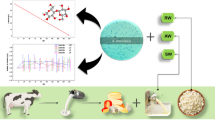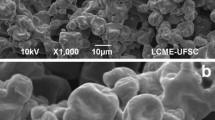Abstract
Cheese whey (CW)-based growth medium efficiently protects Rhizobium loti cells during freezing and desiccation and can maintain their growth in a manner similar to that of traditional mannitol-based medium (YEM). The cheese-whey-based medium (CW) improved viability when used to re-suspend cell pellets kept at −20 °C and −80 °C and resulted in the survival of over 90% of the cells. Moreover, bacterial pellets obtained from cells grown in CW withstand desiccation better than cells grown in YEM. Survival was over 60% after 30 days at 4 °C. No differences were observed in nodulation efficiency between YEM-grown and CW-grown cells. Fast protein liquid chromatography (FPLC) protocols are presented for total protein profile analyses of sweet and acid cheese whey.

Similar content being viewed by others
References
Andrews AT, Taylor MD, Owen AJ (1985) Rapid analysis of bovine milk proteins by fast protein liquid chromatography. J Chromatogr 348:177–185
2- Bissonnette N, Lalande (1988) High survivability of cheese whey-grown Rhizobium meliloti cells upon exposure to physical stress. Appl Environ Microbiol 54:183–187
Chaplin LC (1986) Hydrophobic interaction fast protein liquid chromatography of milk proteins. J. Chromatogr 363:329–335
Fulchieri MM, Estrella MJ, Iglesias AA (2001). 1–4. Characterization of Rhizobium loti strains from the Salado River Basin. Anton Leeuw Int J Gen and Mol Microbiol 79:119–125
Gonzalez Siso MI 1(996) The biotechnological utilisation of cheese whey: a review. Biores Technol 57:1–11
Lowry OH, Rosebrough NJ, Farr AL, RJ Randall (1951) Protein measurement with Folin-phenol reagent. J Biol Chem 193:265–275
Martinez de Drets G, Arias A, Rovira de Cutinella M (1974) Fast and slow-growing rhizobia: differences in sucrose utilisation and invertasa activity. Can J Microbiol 20:605–609
Montes L (1987) Current research on Lotus tenuis in Balcarce (Argentina). Lotus Newslett 18:13–15
Monza J, Fabiano E, Arias A (1992) Characterization of an indigenous population of rhizobia nodulating Lotus corniculatus. Soil Biol Biochem 24:241–247
Musale DA, Kulkarni SS (1998) Effect of whey composition on ultrafiltration perfomence. J Agric Food Chem 46:4717–4722
Nielsen S (1996) Introduction to the chemical analysis of foods. Jones and Barlett, Boston
Pankhurst CE (1977) Symbiotic effectiveness of antibiotic-resistant mutants of fast- and slow-growing strains of Rhizobium- nodulating Lotus species. Can J Microbiol 23:1026–1033
Pearson D (1970) The chemical analysis of foods, 6th edn. Churchill, London
Robyt JF, Whelan. WJ (1972) Reducing value methods for maltodextrins: I Chain-length dependence of alkaline 3,5-dinitrosalicylate and chain-length independence of alkaline copper. Anal Biochem 45:510–516
Vincent JM (1970) A manual for the practical study of the root-nodule bacteria. I.B.P. Handbook. no. 15. Blackwell, Oxford
Acknowledgements
This work was supported by a grant from the Consejo Nacional de Investigaciones Científicas y Tecnológicas (CONICET-Argentina). MJE is a professional researcher and a member of the Comisión de Investigaciones Científicas de la Provincia de Buenos Aires (CIC). FLP is a fellow of Fundación Consejo Regional de la Producción (COREPRO). LED and OAR are career researchers of CONICET. We are grateful to M. Rodriguez (Gándara S.A., Chascomús. Argentina), who provided the cheese whey samples and collaborated in their analysis. We also wish to thank Professor Rex Davis for his help with English.
Author information
Authors and Affiliations
Corresponding author
Additional information
In memoriam of Sylvio Cortina Vicepresident of Fundación COREPRO
Rights and permissions
About this article
Cite this article
Estrella, M.J., Pieckenstain, F.L., Marina, M. et al. Cheese whey: an alternative growth and protective medium for Rhizobium loti cells. J IND MICROBIOL BIOTECHNOL 31, 122–126 (2004). https://doi.org/10.1007/s10295-004-0124-y
Received:
Accepted:
Published:
Issue Date:
DOI: https://doi.org/10.1007/s10295-004-0124-y




